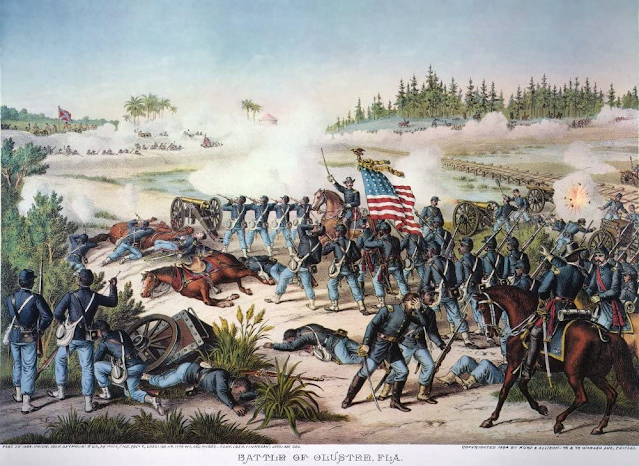Many white Union veterans had a deep respect for their black comrades in arms (check out Barbara Gannon’s The Won Cause, which shows how discrimination against blacks among veterans’ organizations was actually the exception rather than the rule). Louis Kurz was evidently among them, as he depicted black soldiers in a favorable light. I’ve already covered his use of helpful black civilians in the Monitor-Merrimac lithograph. This section contains three examples covering events from mid-1863 to early 1864.
Storming Fort Wagner

The summer of 1863 saw many attempts to capture the birthplace of secession: Charleston, South Carolina. In July General Quincy A. Gilmore sought to force Fort Sumter’s capture or surrender by seizing Morris Island and its Battery Wagner as a launching pad. The Federals landed on the island, but were not able to take the main objective. On July 18 the 54th Massachusetts, a regiment with Abolitionist white officers and mostly free northern blacks in the enlisted ranks, led a costly assault on Battery Wagner. The heavily outnumbered Confederates managed to repel the Union assault and only protracted siege warfare led to their abandonment of their post. Though a defeat, the battle proved to many that black soldiers could fight just as well as whites.
Kurz seems to borrow from other operations in Charleston Harbor. Union gunboats blaze away at Fort Sumter, an event that occurred months earlier on April 7. The largest inaccuracy is the time. The assault occurred at night to provide more cover for the assailants but Kurz puts it in daylight. As is often the case Colonel Robert Gould Shaw gets prominent placement, shown here being shot and killed right by the American flag. There’s quite a bit of hand-to-hand combat on the lower third of the lithograph. Kurz decides to depict the Confederates in red-fringed uniforms, which suggests an artillery unit (though in reality most of the defenders were infantry).
Battle of Olustee
Early in 1864 President Lincoln approved the Florida Expedition. The objective was to cut the state and its beef herds from the rest of the Confederacy and to establish a pro-Union state government before the 1864 elections. General Truman Seymour led the initial force in an indecisive manner, oscillating between caution and aggressiveness. This gave the Confederates time to receive and consolidate reinforcements. When the force met on February 20 near Olustee, Seymour sent his regiments in piecemeal. The Confederates savaged most of his regiments and sent them retreating all the way to the Atlantic Coast.
Kurz focuses on black soldiers at the battle (there were three regiments of them). They back up an undermanned battery, surrounded by dead horses. It’s telling that Kurz preferred to highlight their contribution. This is most likely the 54th Massachusetts, which arrived at the final phase and was twice credited with saving Seymour’s force from total destruction. Most of the inaccuracy comes from the terrain. It looks like the region the battle was fought in, but everything is placed incorrectly. There was a railroad bridge, but it did not cross through a swamp, which was on the flanks of the battle lines. Kurz further shows the Confederates fighting from their entrenchments. Their battle plan was to draw the Federals into an attack on these, but in reality they failed to do so and had to march into the open to fight.
The Fort Pillow Massacre

This is one of Kurz’s more unusual choices. On April 12, 1864, General Nathan Bedford Forrest’s cavalry approached Fort Pillow on the Mississippi River. Forrest demanded the post’s surrender, which was refused. In the ensuing assault, the Confederates scored a one-sided victory. Controversially over 200 men out of a 600 man garrison were killed, much more than the wounded tally. This indicated a massacre. The fort was largely defended by black troops and Tennessee Unionists, boiling the blood of the Confederates (Forrest tried to argue that the defenders were drunk and would not surrender). Fort Pillow is one of the most well known war crimes of the Civil War and the greatest stain on Forrest’s career.
I say this is an unusual choice because lithographs were put on display in homes. A horrific massacre of unarmed soldiers, women, and children is not something one would like to show off, but it would definitely spark a conversation. I myself was very disturbed when, as a kid, I saw this image. Kurz’s Union bias is evident as he manages to exaggerate an already terrible moment in history.. There was no record of women and children among the garrison, much less the massacred. There is a bit of actual fighting at the top left corner, as well as the defiant mother wielding a rock and grappling with a knife-wielding Confederate. The terrain is a bit odd. Instead of the inside of a fort Kurz places large rocks and a pool.

No comments:
Post a Comment